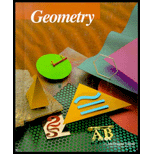
Find whether the actual area of the shaded region is more of less than the value given by computer program.
Answer to Problem 3E
Less
Explanation of Solution
Given:
The shaded region is bounded by the graph of
Calculation:
Computer Program:
We can approximate the area of the shaded region by drawing 1000 rectangles having base vertices at x = 0 , 0.001 , 0.002, 0.003,…,1.000 , and computing the sum of the areas of the 1000 rectangles.The base of each rectangle is 0.001 , and the height of each rectangle is given by
The following comuter program will comute and add the areas of the 1000 rectangles .In line 30, Y is the height of each rectangle.In line 40, A gives the current total of all the areas.
If the program is run , the computer will print :
AREA IS APPROXIMATELY 0.333833
Actual Calculation:
We find the area of the shaded region by
So, the actual area of the shaded region is less than the value computed by the computer program.
Chapter 11 Solutions
McDougal Littell Jurgensen Geometry: Student Edition Geometry
Additional Math Textbook Solutions
A First Course in Probability (10th Edition)
Elementary Statistics (13th Edition)
University Calculus: Early Transcendentals (4th Edition)
Calculus: Early Transcendentals (2nd Edition)
Algebra and Trigonometry (6th Edition)
Thinking Mathematically (6th Edition)
- Door 87.5in to 47 living 44.75 Closet 96in Window ISS.Sin 48in Train Table 96in 48in 132:2 Windowarrow_forward39 Two sides of one triangle are congruent to two sides of a second triangle, and the included angles are supplementary. The area of one triangle is 41. Can the area of the second triangle be found?arrow_forwardA parallelogram with an area of 211.41 m^2 hast a base Thatcher measures 24.3m. Find ist height.arrow_forward
 Elementary Geometry For College Students, 7eGeometryISBN:9781337614085Author:Alexander, Daniel C.; Koeberlein, Geralyn M.Publisher:Cengage,
Elementary Geometry For College Students, 7eGeometryISBN:9781337614085Author:Alexander, Daniel C.; Koeberlein, Geralyn M.Publisher:Cengage, Elementary Geometry for College StudentsGeometryISBN:9781285195698Author:Daniel C. Alexander, Geralyn M. KoeberleinPublisher:Cengage Learning
Elementary Geometry for College StudentsGeometryISBN:9781285195698Author:Daniel C. Alexander, Geralyn M. KoeberleinPublisher:Cengage Learning

